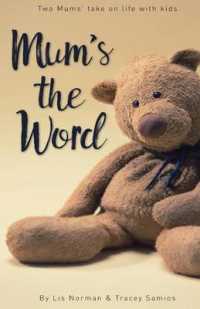- ホーム
- > 洋書
- > 英文書
- > Cinema / Film
基本説明
Outlining a comprehensive theory of film stereotype, a device as functionally important to film narrative as it is problematic, Jörg Schweinitz builds and overlooked critical history from the 1920s to today.
Full Description
Since the early days of film, critics and theorists have contested the value of formula, cliche, conventional imagery, and recurring narrative patterns of reduced complexity in cinema. Whether it's the high-noon showdown or the last-minute rescue, a lonely woman standing in the window or two lovers saying goodbye in the rain, many films rely on scenes of stereotype, and audiences have come to expect them. Outlining a comprehensive theory of film stereotype, a device as functionally important as it is problematic to a film's narrative, Jorg Schweinitz constructs a fascinating though overlooked critical history from the 1920s to today. Drawing on theories of stereotype in linguistics, literary analysis, art history, and psychology, Schweinitz identifies the major facets of film stereotype and articulates the positions of theorists in response to the challenges posed by stereotype. He reviews the writing of Susan Sontag, Roland Barthes, Theodor W.
Adorno, Rudolf Arnheim, Robert Musil, Bela Balazs, Hugo Munsterberg, and Edgar Morin, and he revives the work of less-prominent writers, such as Rene Fulop-Miller and Gilbert Cohen-Seat, tracing the evolution of the discourse into a postmodern celebration of the device. Through detailed readings of specific films, Schweinitz also maps the development of models for adapting and reflecting stereotype, from early irony (Alexander Granowski) and conscious rejection (Robert Rossellini) to critical deconstruction (Robert Altman in the 1970s) and celebratory transfiguration (Sergio Leone and the Coen brothers). Altogether a provocative spectacle, Schweinitz's history reveals the role of film stereotype in shaping processes of communication and recognition, as well as its function in growing media competence in audiences beyond cinema.
Contents
List of Illustrations Introduction Part I. Stereotype Theory: Concepts, Perspectives, and Controversies 1. The Stereotype in Psychology and the Humanities 2. Some Aspects and Levels of Stereotypization in Film 3. The Intellectual Viewpoint Versus the Stereotype in Mass Culture Part II. A Discourse History: The Topic of the "Stereotype" Throughout Film Theory 4. Prelude: Walther Rathenau's Cultural Criticism, Hugo Munsterberg's Euphoric Concept of Film as Art, and the Neglect of the Stereotype 5. Bela Balazs's New Visual Culture, the Tradition of Linguistic Skepticism, and Robert Musil's Notion of the "Formulaic" 6. The Readymade Products of the Fantasy Machine: Rudolf Arnheim, Rene Fulop-Miller, and the Discourse on the "Standardization" of Film 7 The Stereotype as Intelligible Form: Cohen-Seat, Morin, and Semiology 8. Irony and Transf iguration: The Postmodern View of the Stereotype Part III. Film Analysis: Critique and Transfiguration-Three Case Studies 9. McCabe and Buffalo Bill: On the Critical Reflection of Stereotypes in Two Films by Robert Altman 10. Enjoying the Stereotype and Intense Double-Play Acting: The Performance of Jennifer Jason Leigh in The Hudsucker Proxy Epilogue Notes Bibliography Filmography Index








